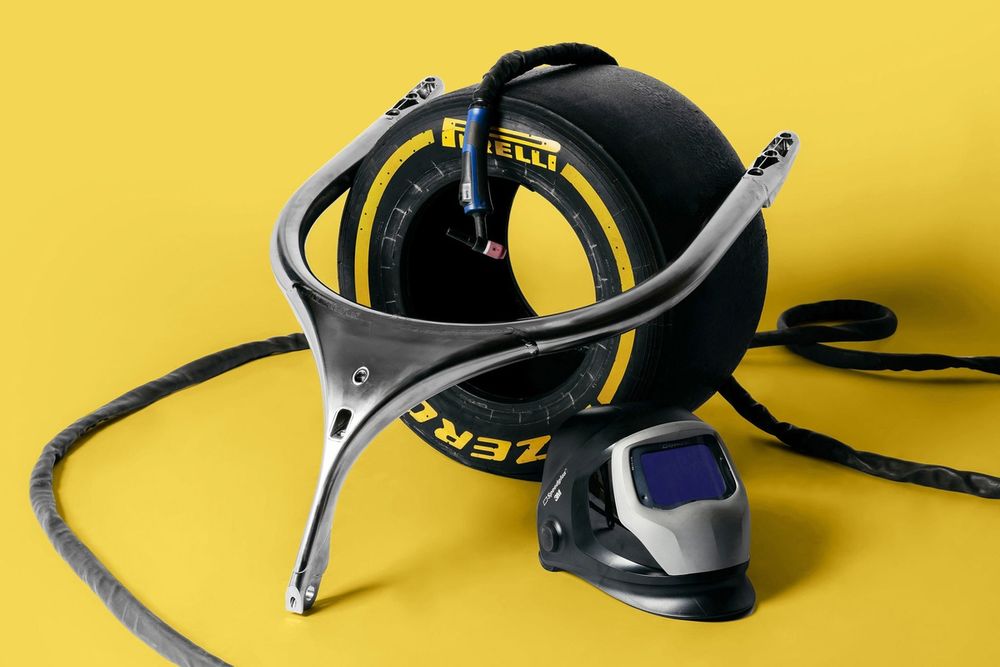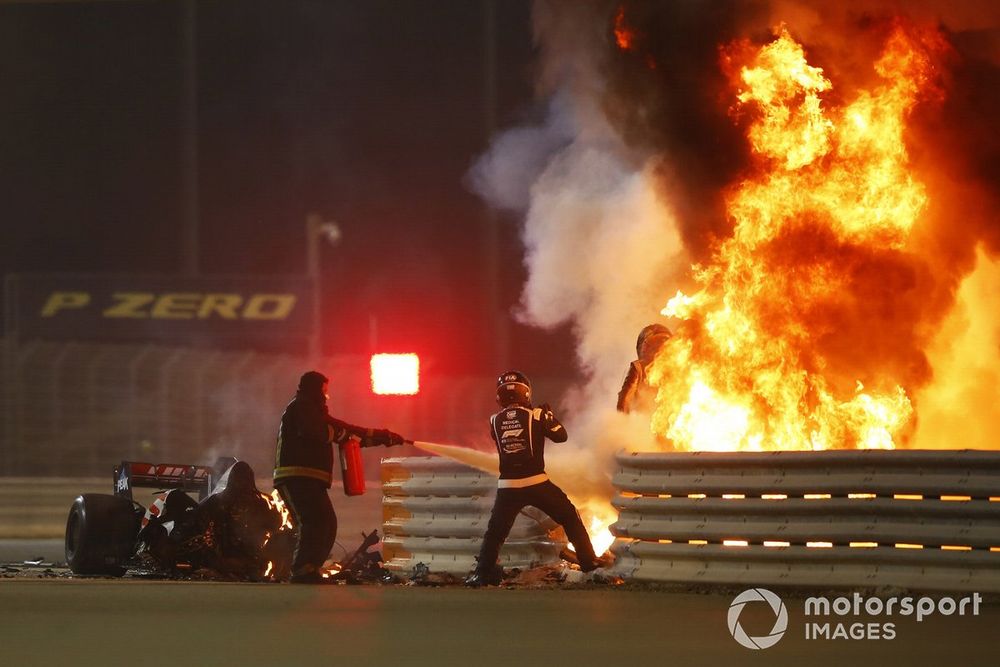When Romain Grosjean’s Haas automobile break up in two and burst into flames throughout the 2020 Bahrain Grand Prix, it was the titanium halo that in the end saved his life. However what few individuals know is {that a} groundbreaking welding method performed a vital function in making the halo robust sufficient to carry out as designed in that terrifying second.
The halo, now a vital a part of Components 1’s security package deal, confronted robust opposition when it was first launched in 2018. Nevertheless, a number of high-profile crashes – together with Grosjean’s fiery accident, Zhou Guanyu’s dramatic flip at Silverstone in 2022, and the Verstappen-Hamilton conflict at Monza in 2021 – have since silenced the critics. The cockpit safety system has confirmed its value repeatedly.
However what not many individuals know is that manufacturing the halo to satisfy the FIA’s security requirements – to resist the immense forces it would face, the halo needed to be able to supporting the burden of a London double-decker bus – posed a significant technical problem, one which conventional manufacturing strategies could not clear up. This required not solely high-grade titanium but in addition a flawless, progressive welding course of to protect the fabric’s properties.
The problem of welding titanium
By the tip of 2017, the businesses that participated within the FIA’s tender for the manufacturing of the halo – together with the social gathering that in the end received the contract – didn’t have the in-house technical capabilities to weld the 5 titanium elements of the halo to the very best doable high quality. That is after they turned to LKN WeldTitan, the titanium-specialized division of Dutch firm LKN WeldCompany BV. After almost 4 weeks of intensive analysis and growth, they succeeded in welding the elements collectively in a method that fully preserved the titanium’s technical properties, guaranteeing that the halo met FIA’s stringent requirements.
“Titanium is a reactive metallic, which implies it reacts with parts within the air – even at room temperature, in a way that oxidation happens,” explains Patrick Wouterse, founder and CEO of LKN WeldCompany, chatting with Autosport. “That is why it is extremely proof against corrosion: as soon as a skinny oxide layer types, it protects the metallic from additional oxidation, a property that makes titanium ultimate for chemical industries.”
Zhou Guanyu, Alfa Romeo C42 crashes at begin of race
Picture by: Mark Sutton / Motorsport Pictures
However for the halo, the important thing property wasn’t simply corrosion resistance however the strength-to-weight ratio. “Titanium, particularly the grade 5 alloy used for the halo, is way stronger than metal whereas being considerably lighter,” Wouterse continues. “The place you’d want 15 millimetres of stainless-steel for a sure power, you would possibly solely want 5 millimetres of titanium. That is why it is used extensively in aerospace and why it was chosen for the halo. You need the strongest doable construction with out including an excessive amount of weight to the automobile.”
Nevertheless, welding titanium is a fragile course of, as heating the metallic causes it to develop into much more reactive, making it soak up parts like oxygen and hydrogen “like a sponge in a bucket of water”. Even the slightest contamination, equivalent to microscopic traces of filth or oils from a fingerprint, can have already got disastrous penalties for the power of the titanium within the space the place the weld is.
“As soon as titanium absorbs these parts, it adjustments the metallic’s composition and weakens it dramatically, as much as 75% within the affected space,” Wouterse explains. “To forestall that, you’ll want to create an surroundings the place, throughout welding, no different parts can attain the metallic.”
The innovation: a flawless welding course of inside a purge chamber
Usually, welders shield the realm with an area movement of inert gasoline, like argon, to defend the molten metallic. However with titanium, that is not sufficient. “The warmth radiates outward — the encircling materials can attain 1,000 levels Celsius. However at simply 150 levels, titanium already begins absorbing oxygen,” says Wouterse.
“You possibly can truly see the harm — the titanium adjustments color. Silver means the properties are intact, whereas gold signifies that there was a really slight however acceptable deterioration. But when it turns blue, purple, or inexperienced, the fabric is basically ruined.”

Titanium halo
Picture by: LKN WeldCompany BV
To resolve this, Wouterse and his staff spent years perfecting a singular welding course of, constructing specialised welding purge chambers, so the welding can happen in an environment of inert gasoline.
“It sounds easy – simply put the elements in a field and fill it with argon – but it surely’s extraordinarily complicated,” Wouterse says. The issue is that there at all times stays a small quantity of oxygen within the purge chamber. “We fill the chamber primarily with argon, helium and neon. However argon is heavy, oxygen is mild, and helium is even lighter. Even the slightest turbulence from transferring your fingers contained in the gloves can combine the gases and lift oxygen ranges.”
“We needed to discover methods to get the oxygen focus right down to only a few elements per million,” Wouterse continues. “All the pieces, from the form of the chamber to the wall end, impacts the outcome. In order that’s all very difficult. And there are no less than fifteen different variables that every one must be excellent to get the suitable values.”
Over the previous 20 years, Wouterse has specialised on this course of. By means of LKN WeldCompany BV, he has constructed a robust fame, resulting in world demand for his firm’s experience in specialised welding tasks throughout industries equivalent to aerospace, vitality, chemical, nuclear, pharmaceutical, and automotive. As well as, Wouterse is often employed by corporations for course of growth and high quality management.
After FIA’s halo provider reached out to LKN by way of a mutual connection, the Amersfoort-based firm developed a customized welding chamber massive sufficient to accommodate the whole halo jig, considering the construction’s complicated, asymmetrical hole design. “We then certified the method in response to EN ISO requirements, welded a prototype and examined it – it simply met the FIA’s requirements,” Wouterse remembers. “After that, we moved shortly into manufacturing. We ended up welding the primary hundred halos for Components 1 in early 2018.”

Romain Grosjean, Haas F1, emerges from flames after a horrific crash on the opening lap of the Bahrain Grand Prix, Marshals attend the accident
Picture by: Andy Hone / Motorsport Pictures
A life-saving legacy
For Wouterse, seeing the halo in motion – particularly throughout crashes like Grosjean’s – is a supply of immense pleasure. “In fact, you at all times hope nothing unhealthy occurs. However when it does, it is good to know there is a halo on that automobile. It makes you proud to suppose, ‘We helped make that’.
“Particularly to start with, so many individuals hated the halo — they thought it was ugly whereas a number of the drivers stated it obstructed their view. However after the primary large crash the place the halo made the distinction, all of the criticism stopped. Everybody agreed it was the suitable factor.”
Grosjean’s crash left a long-lasting impression on Wouterse. “If you take a look at simulations that had been made after the incident, you see how the halo deformed the barrier simply sufficient to guard Grosjean’s head. With out it, he would not have survived. And since the halo held, he was additionally capable of climb out of the burning wreckage.”
Wouterse even exchanged messages with Grosjean afterward. “I reached out on LinkedIn and defined our function within the halo. He replied, ‘Then I suppose I must thanks.’ As an enormous Components 1 fan myself, that meant rather a lot.”
Later this 12 months, Wouterse plans to go to the F1 Exhibition in Amsterdam to see Grosjean’s burned-out chassis in particular person — a strong reminder of the life-saving know-how he and his staff helped excellent.
On this article
Be the primary to know and subscribe for real-time information e mail updates on these subjects
Subscribe to news alerts